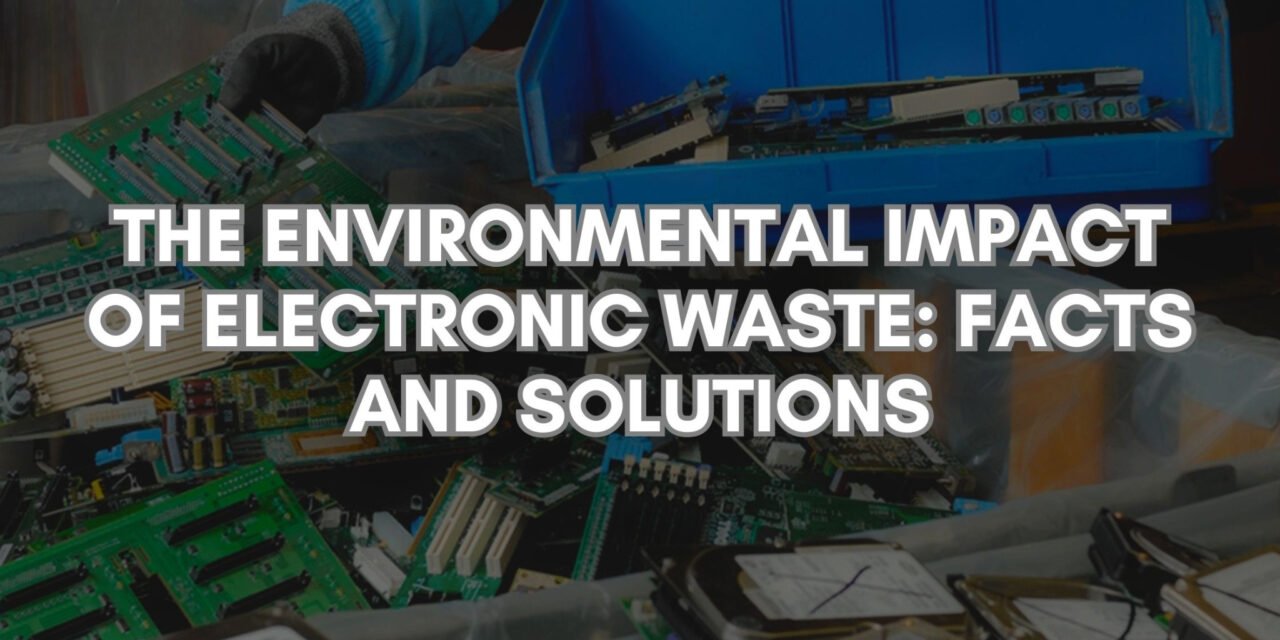Electronic waste (e-waste) refers to discarded electronic devices and components that are no longer in use, such as old smartphones, computers, televisions, and other electronic gadgets. E-waste has significant environmental impacts, and addressing these concerns has become a major focus for the electronics industry. Here are the key environmental impacts of e-waste and how the industry is addressing them:
Environmental Impacts of E-Waste:
- Toxic Chemicals and Heavy Metals:
- Many electronic devices contain hazardous materials such as lead, mercury, cadmium, and brominated flame retardants.
- When e-waste is improperly disposed of, these toxic substances can leach into soil and water, causing contamination and posing risks to both human health and wildlife.
- For instance, lead exposure can affect the nervous system, while mercury is toxic to aquatic ecosystems.
- Pollution from Landfills and Incineration:
- Disposing of e-waste in landfills can result in long-term environmental damage as materials like plastics and metals degrade slowly, releasing harmful chemicals into the environment.
- E-waste incineration can release dioxins and other harmful pollutants into the air, further contributing to air pollution and global warming.
- Resource Wastage:
- Many electronic devices contain valuable materials, such as gold, silver, copper, and rare earth elements, which are often discarded when e-waste is improperly handled.
- The loss of these materials means that valuable resources are not being recycled or reused, leading to a waste of raw materials and increased demand for mining and extraction.
- Energy Consumption in Processing:
- Extracting and recycling metals from e-waste requires significant amounts of energy, contributing to increased carbon emissions if not done using renewable energy sources.
- Many e-waste recycling processes involve high energy costs for material separation and refining.
- Health Risks to Workers in Informal Recycling Sectors:
- In some developing countries, e-waste is processed informally by workers who dismantle electronic devices without proper safety equipment.
- This exposes workers to dangerous chemicals and toxic substances, leading to serious health risks, including respiratory problems, neurological damage, and skin conditions.
How the Industry is Addressing E-Waste:
- E-Waste Recycling and Circular Economy:
- Recycling Programs: Many electronics companies are implementing take-back programs and recycling initiatives to encourage consumers to return old devices. This helps ensure that valuable materials like gold, silver, and rare earth metals are recovered and reused.
- Closed-Loop Recycling: Companies like Apple and HP are leading the way in developing closed-loop recycling systems, where products are designed to be easily disassembled and recycled, allowing materials to be continuously reused in manufacturing.
- WEEE (Waste Electrical and Electronic Equipment) Directive: In regions like the European Union, the WEEE Directive mandates that manufacturers are responsible for the collection, recycling, and environmentally friendly disposal of e-waste.
- Designing for Longevity and Sustainability:
- Product Durability: Companies are designing products to last longer, reducing the frequency of replacement. Devices with longer lifespans generate less e-waste over time.
- Modular Design: Some companies are adopting modular designs, allowing consumers to upgrade or replace specific parts (like batteries, screens, or processors) instead of discarding the entire device. This can significantly extend the product’s life cycle.
- Eco-friendly Materials: Manufacturers are increasingly using recyclable materials, such as biodegradable plastics and recycled metals, to minimize environmental impacts.
- E-Waste Disposal Standards:
- Governments and organizations are establishing regulations and standards for the safe disposal and recycling of e-waste. This includes ensuring that e-waste is processed in certified, environmentally responsible recycling facilities.
- Certified Recycling Facilities: Facilities that process e-waste must meet specific Environmental, Health, and Safety (EHS) standards. Certifications like R2 (Responsible Recycling) and e-Stewards provide guidelines for proper e-waste recycling.
- Consumer Awareness and Education:
- The electronics industry is working to raise awareness among consumers about the environmental impacts of e-waste and the importance of proper disposal.
- Companies are promoting recycling initiatives and providing information on how consumers can dispose of their old devices in an environmentally friendly manner, such as through collection events or designated e-waste drop-off points.
- Extended Producer Responsibility (EPR):
- EPR programs make manufacturers responsible for the entire life cycle of their products, including the end-of-life phase. This encourages them to take steps to reduce waste, use sustainable materials, and invest in recycling programs.
- Product Takeback Schemes: Some manufacturers have established product takeback schemes, where consumers can send back their old electronics for recycling or refurbishment.
- Innovations in E-Waste Processing:
- Advances in e-waste recycling technologies are improving the efficiency and environmental safety of processing old electronics. Innovations such as hydrometallurgical methods for extracting valuable metals and bioleaching techniques are being explored as more sustainable alternatives to traditional methods.
- Artificial Intelligence (AI) is being used to automate sorting and disassembly in e-waste recycling, making the process faster and more efficient.
- Second-Hand Markets and Refurbishment:
- Refurbishment Programs: Some companies, like Apple and Dell, offer refurbished devices, which can be sold at lower prices. These devices are repaired, tested, and resold, extending their lifespan and reducing the need for new products.
- The second-hand market for electronics, including smartphones, laptops, and tablets, is growing, with many consumers opting to buy used or refurbished devices.
Conclusion:
The environmental impacts of e-waste are significant, but the electronics industry is taking steps to address these challenges. Through recycling initiatives, designing for sustainability, adopting regulations and standards, and promoting consumer awareness, the industry is working toward reducing the harmful effects of e-waste. However, continued efforts are needed to improve recycling technologies, extend product lifespans, and create a circular economy that minimizes the environmental footprint of electronic products.
Hashtags
#EwastePollution #EwasteDisposal #ToxicEwaste #HazardousWasteFromElectronics #EwasteImpactOnEnvironment #EwasteContamination #PollutionFromEwaste #EwasteDegradation #EnvironmentalToxinsInEwaste #EwasteRisks #SustainableEwasteDisposal #EwasteRecycling #EwasteManagement #EcoFriendlyEwasteSolutions #RecyclingElectronicWaste #CircularEconomyForEwaste #EwasteRecyclingPrograms #EwasteRecovery #ReusingEwaste #RecyclingElectronicComponents #ResourceConservationThroughEwaste #ReducingEwasteImpact #RecyclingPreciousMetals #ConservingResourcesWithEwaste #ReducingElectronicWaste #EwasteAsResource #RecyclingMaterialsInEwaste #SustainableResourceManagement #RecycledElectronics #PreciousMetalsRecycling #ElectronicsIndustryEwasteSolutions #EwasteManagementInitiatives














